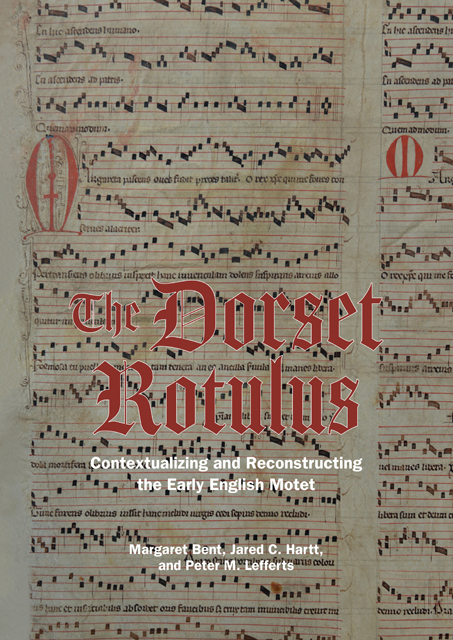Book contents
- Frontmatter
- Contents
- List of Figures
- List of Music Examples
- List of Tables
- Abbreviations
- Note on the Transcriptions
- Introduction
- 1 The Source and its Contents
- 2 Contexts and Designs
- 3 Voice-Exchange Motets and Ascendenti sonet geminacio/ Viri Galilei
- 4 Margareta pascens oves and its Large-Scale Comparands
- 5 Rota versatilis: Towards a Reconstruction
- 6 The Curious Case of Regina preminencie/ Gemma nitens/ … mater es intacta
- 7 Introducing Naufragantes visita/ Navigatrix inclita/ T. Aptatur/ … velox perpetrat
- 8 The Musical Rotulus: Artifact, Image, and Attributes
- 9 Epilogue: Conclusions and Speculation
- Appendix: Transcriptions, Texts, and Translations of the Four Dorset Motets
- Bibliography
- Index of Manuscripts
- Index of Musical Compositions
- General Index
- Studies in Medieval and Renaissance Music
4 - Margareta pascens oves and its Large-Scale Comparands
Published online by Cambridge University Press: 14 January 2023
- Frontmatter
- Contents
- List of Figures
- List of Music Examples
- List of Tables
- Abbreviations
- Note on the Transcriptions
- Introduction
- 1 The Source and its Contents
- 2 Contexts and Designs
- 3 Voice-Exchange Motets and Ascendenti sonet geminacio/ Viri Galilei
- 4 Margareta pascens oves and its Large-Scale Comparands
- 5 Rota versatilis: Towards a Reconstruction
- 6 The Curious Case of Regina preminencie/ Gemma nitens/ … mater es intacta
- 7 Introducing Naufragantes visita/ Navigatrix inclita/ T. Aptatur/ … velox perpetrat
- 8 The Musical Rotulus: Artifact, Image, and Attributes
- 9 Epilogue: Conclusions and Speculation
- Appendix: Transcriptions, Texts, and Translations of the Four Dorset Motets
- Bibliography
- Index of Manuscripts
- Index of Musical Compositions
- General Index
- Studies in Medieval and Renaissance Music
Summary
The surviving lower portion of the recto of the Dor rotulus preserves most of the two upper voices of the now longest known voice-exchange motet, Margareta pascens oves. Its highly descriptive text recounts spectacular events from the vita of St Margaret of Antioch. Until now, most of this four-voice motet was unknown to scholars, as was its impressive size: four strips from Fountains contain only a small portion of one upper voice, which is now confirmed to come from the end of the motet, and a substantial portion of one of the tenor voices, whose textual incipits indicate that it comes from the middle sections of the motet. But with the discovery of Dor – and in combination with Fountains – its poetic text is now complete, the two upper voices are nearly wholly extant, about 40 percent of one tenor voice survives, and its overall length and structure become clear, totaling a mammoth 382 longs (including voice-exchange repeats) organized into seven sections.
The primary objectives of this chapter are threefold: to introduce, contextualize, and reconstruct this fascinating motet. Accordingly, the following first presents an account of what survives in Dor and Fountains, illustrates how the sources fit together, and in the process elucidates Margareta’s salient textual, melodic, and formal characteristics. Next, an examination of three large-scale comparands reveals many characteristics shared amongst themselves and with Margareta, along with several interesting differences, including a variety of ways of delineating structure; these other large-scale compositions likewise exemplify the high degree of innovation and experimentation established in the previous chapter with the smaller-scale voice-exchange motets. Finally, due in part to Margareta’s kinship with its comparands, and by drawing on melodic and sonorous features of those motets, a reconstruction of the entire four-voice texture of Margareta is offered.
Margareta Pascens Oves
What survives
Margareta is notated in Dor in two parallel columns, and as in Ascendenti/Viri above it, the right-hand column has been trimmed away vertically about half way across (Figure 1.2 in Chapter 1). But because the two extant voices – Cantus I on the left and Cantus II on the right – repeat through exchange in each section of the motet, reconstruction of the text and pitch of Cantus II missing from the trimmed right-hand column is straightforward.
- Type
- Chapter
- Information
- The Dorset RotulusContextualizing and Reconstructing the Early English Motet, pp. 107 - 174Publisher: Boydell & BrewerPrint publication year: 2021



